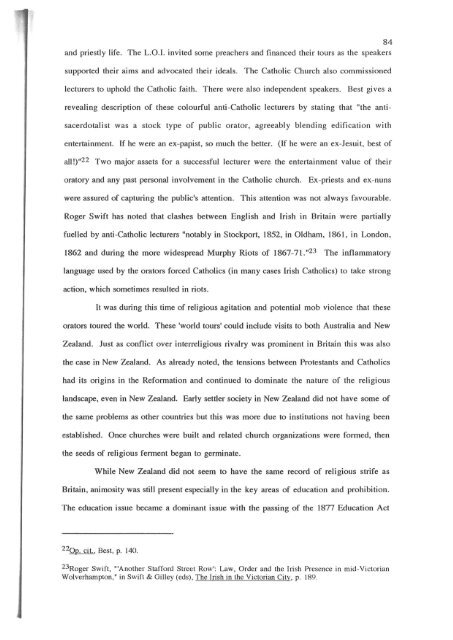TRANSPLANTED IRISH INSTITUTIONS - University of Canterbury
TRANSPLANTED IRISH INSTITUTIONS - University of Canterbury
TRANSPLANTED IRISH INSTITUTIONS - University of Canterbury
Create successful ePaper yourself
Turn your PDF publications into a flip-book with our unique Google optimized e-Paper software.
84<br />
and priestly life. The L.O.I. invited some preachers and financed their tours as the speakers<br />
supported their aims and advocated their ideals. The Catholic Church also commissioned<br />
lecturers to uphold the Catholic faith. There were also independent speakers. Best gives a<br />
revealing description <strong>of</strong> these colourful anti-Catholic lecturers by stating that "the antisacerdotalist<br />
was a stock type <strong>of</strong> public orator. agreeably blending edification with<br />
entertainment. lf he were an ex-papist. so much the better. (If he were an ex-Jesuit. best <strong>of</strong><br />
all!)"22 Two major assets for a successful lecturer were the entertainment value <strong>of</strong> their<br />
oratory and any past personal involvement in the Catholic church. Ex-priests and ex-nuns<br />
were assured <strong>of</strong> capturing the public's attention. This attention was not always favourable.<br />
Roger Swift has noted that clashes between English and Irish in Britain were partially<br />
fuelled by anti-Catholic lecturers "notably in Stockport. 1852, in Oldham, 1861. in London,<br />
1862 and during the more widespread Murphy Riots <strong>of</strong> 1867-71."23 The inflammatory<br />
language used by the orators forced Catholics (in many cases Irish Catholics) to take strong<br />
action, which sometimes resulted in riots.<br />
It was during this time <strong>of</strong> religious agitation and potential mob violence that these<br />
orators toured the world. These 'world tours' could include visits to both Australia and New<br />
Zealand. Just as conflict over interreligious rivalry was prominent in Britain this was also<br />
the case in New Zealand. As already noted, the tensions between Protestants and Catholics<br />
had its origins in the Reformation and continued to dominate the nature <strong>of</strong> the religious<br />
landscape. even in New Zealand. Early settler society in New Zealand did not have some <strong>of</strong><br />
the same problems as other countries but this was more due to institutions not having been<br />
established. Once churches were built and related church organizations were formed. then<br />
the seeds <strong>of</strong> religious ferment began to germinate.<br />
While New Zealand did not seem to have the same record <strong>of</strong> religious strife as<br />
Britain, animosity was still present especially in the key areas <strong>of</strong> education and prohibition.<br />
The education issue became a dominant issue with the passing <strong>of</strong> the 1877 Education Act<br />
220p. cit., Best, p. 140.<br />
23Roger Swift, "'Another Stafford Street Row': Law, Order and the Irish Presence in mid-Victorian<br />
Wolverhampton," in Swift & Gilley (eds), The Irish in the Victorian City, p. 189.
















